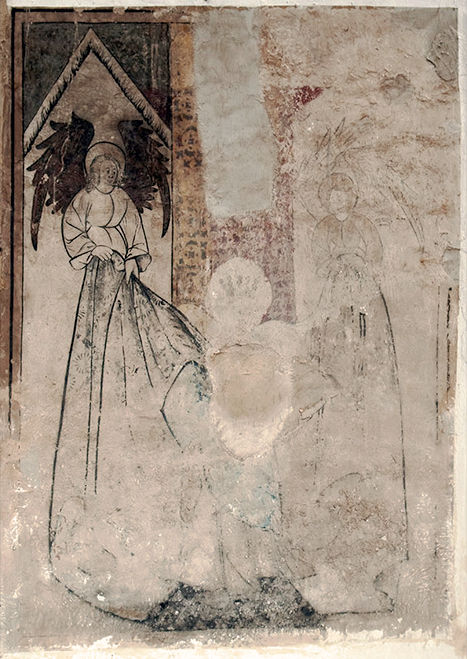Arundel Priory, Sussex (†Chichester) C.15
The Virgin Mary, with Attendant Angels

This painting of the Virgin, crowned and apparently enthroned between two angels holding up her voluminous train, has been very heavily restored – repainted, in effect – and treated with wax in the past This accounts for the unnatural discolouration of parts of it – the unlikely black wings of the angel on the left, for example. Additionally, some damage has been done by the removal in 1873 of a gallery above its position in the north aisle, and as a result of all this, it presents a few problems.
In the centre is a rectangular red area, apparently patterned, and probably intended for a ‘cloth of honour’ hanging behind the Virgin’s head. I have never seen this in an English wall painting before, but cloths of honour are found in 15th century Continental, particularly Netherlandish, paintings of the Virgin. Against the lower part of it, her head and face reduced to a halo and and a faint outline of a crown, is the Virgin herself.
The leaflet in the church describes the painting as the Coronation of the Virgin, but there is no space here for a figure of Christ, or a third angel to perform the crowning, and the painting is very remote in iconography, style and spirit from provincial English versions of that subject. The closest relative of the painting on this site is probably the 15th century century seated Virgin at Cawston.
The angel at the left stands under a sharply pointed canopy, and there is a suggestion of another above the angel on the right. There is a marked discrepancy between their apparent heights, but this might be the product of restoration. Some vertical lines, which seem to be the outline of something rectangular, are at the far right, but these might be part of some earlier subject.
Finally, in the centre of the scene, where the Virgin’s feet would rest, is a dark area which was once perhaps an embroidered carpet – of a much brighter colour originally. This would make sense in conjunction with the cloth of honour, and given Arundel’s south coast location, further suggests that this painting is the work of someone familiar with Continental conventions in this kind of ‘celebratory’ depiction of the Virgin.